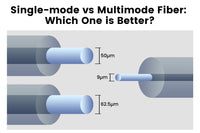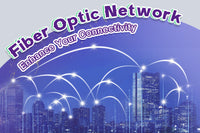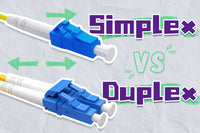Contents
Fiber optic cables are essential in modern network deployment because of the increasing need for higher bandwidth and speed. Multimode and single-mode fiber are two kinds of optic fibers. OM3 and OM4 are the multi-type fiber types for high-bandwidth data transmission. But people can often be confused about these two fiber types with such similar appearance. Choosing OM3 or OM4 can impact your network performance and you need to make an informed choice of how to choose them. Our blog provides guidance on their differences and how to choose between them.
What is OM3 and OM4?
Multimode fiber is a kind of optical fiber often used in short-distance transmission within the building. OM3 and OM4 are upgraded versions of OM2, and they are both laser-optimized multimode fibers with 50/125µm fiber cores. With higher performance, both OM3 and OM4 are designed for higher-quality modern data transmission under a wavelength of 850nm.
OM3 is usually used for short-distance data transmission at 10 Gbps speed. OM3 has a better performance than OM2 as it uses an upgraded VCSEL laser. OM3 can support 10 Gbps with a maximum distance of 300 meters and 100 Gbps at 70 meters.
Applying advanced material, OM4 is an enhanced fiber compared to OM3. It is designed to support higher bandwidths and longer distances. Suppose OM3 and OM4 are two roads to the city. OM4 is a longer and wider road to the farther city than OM3, and it keeps traffic flowing at peak times. To simplify identification, some manufacturers may use violet cable jackets for OM4 fibers instead of aqua jackets in Europe. OM4 fiber is backward compatible with OM3 and OM2 fibers, making it an ideal option for a more efficient network deployment with simple cabling and low cost on the base of the existing network.
OM3 vs. OM4: What are the Differences?
OM3 and OM4 share some features like the core size, jacket color, and data rate. But OM4 is an upgraded version of OM3, so it performs better than OM3 in many aspects. We’ll mainly compare OM3 and OM4 from the following aspects:
- Bandwidth
Between OM3 and OM4, it is essential to distinguish the Minimum Effective Modal Bandwidth (EMB), which is the main bandwidth-limiting factor for multimode fibers. OM4 has a higher modal bandwidth of 4700 MHz-km in 850nm measurement wavelength compared to OM3’s EMB of 2000 MHz-km, which means OM4 features a much better transmission performance than OM3. High EMB also brings low optical distortion, so OM4 has a better performance and enhanced reliability than OM3.
- Speed
OM3 fiber is primarily designed for 10 Gbps, but it can support 40 Gbps and 100 Gbps in a shorter distance. On the other hand, OM4 is developed to cater to the growing need for higher-speed data transmission like 40 Gbps and 100 Gbps with a longer distance. With the development of modernization, high-speed data transmission is gradually becoming a prevailing trend. On this side, OM4 is definitely better than OM3’s performance.
- Transmission Distance
The transmission distance of OM3 and OM4 differ depending on varying data rates, including 10 Gbps, 40 Gbps, and 100 Gbps. However, on the same devices, OM4 typically supports longer distances than OM3 at the same data rate. For example, OM3 can reach up to 300 meters at 10 Gbps, while OM4 allows for 500 to 550 meters. In addition, at a higher rate of 40 Gbps or 100 Gbps, OM4 can also reach a further transmission of 150 meters than OM3’s transmission of 100 meters.
- Attenuation
Signal attenuation is an essential consideration when it comes to fiber optic signal transmission. Under similar conditions, OM3 fiber has an attenuation of up to 3.5 dB/km, and OM4 fiber typically provides an attenuation rate of less than 3.0 dB/km. Besides, OM4 is able to decrease insertion loss due to its better attenuation performance. Compared to OM3, OM4 fiber can ensure signal quality and integrity over longer transmission distances.
- Cost
The cost largely depends on the material of fibers, so OM4 fiber of better material has a higher cost than OM3 at the beginning of the investment. However, in the long run, OM4 can save more costs for future network extension and maintenance. So OM4 is more cost-effective than OM3 in the long term.

OM3 vs. OM4: Which is Suitable for Your Need?
The choice between using OM3 or OM4 for your network is up to factors like bandwidth, distance, network speed, and cost.
But generally, OM3 is suitable for small to medium data centers, and mid-range distances between floors and buildings. OM3 is often used for short-distance connection of the data center at a speed of 10 Gbps. It is perfect for inter-rack and intra-rack connections within a data center. OM3 fibers offer connection among network switches, servers, and storage equipment. Small offices or small campus networks are common scenarios that use OM3 fibers. OM3 can support daily data transmission in a small area. For these lower-budget and small-scale network deployments, OM3 must be an optimal choice.
OM4 is ideal for large-scale data centers that have different layers over longer distances. For example, high-speed data transmission meets the requirements for data exchange between servers, storage devices, and switches. To establish a network in a building with many floors like a school, the OM4 fiber is the best choice because it has enough bandwidth and signal strength to achieve smooth signal transmission in such space. Some professional fields like industry, industrial automation and the Internet of Things rely on long-distance, high-speed, and interference-resistant transmission by OM4.
Conclusion
With the need for higher bandwidth, higher speed, and longer transmission distances, fiber optic technology continues to evolve. By understanding the differences and applications of OM3 and OM4, you can make an informed decision and optimize your network infrastructure. As future-proofing technologies, both OM3 and OM4 are suitable solutions for increasingly improved network requirements.
FAQs
Is OM3 and OM4 compatible?
Yes, but to get the optimal performance, it is recommended to use the same type of fiber.
Can OM3 be used for single-mode applications?
No, OM3 fibers are designed for multimode applications.
Does networking hardware specified to work with OM3 fiber also work with OM4 cables? (when the cables support the same wavelength)
Yes, because OM4 is the same as OM3 in appearance, and it is back-compatible with OM3. But the final performance depends on the device itself.
For more information on this topic, you can keep up on our blogs. While VCELINK offers general and basic information for our customers and other visitors to the website, it’s not professional advice.



Be the first one to comment.
Leave a comment